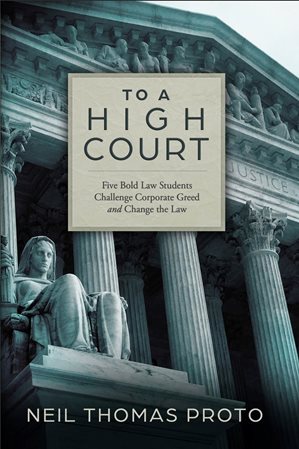Author Chats
On 50th Anniversary of Historic SCRAP Case, Neil Proto Reflects on Its Impact on the Legal Profession
July 21, 2023
In 1971 Neil Thomas Proto and four other George Washington University law students formed Students Challenging Regulatory Agency Procedures (SCRAP) to dispute the failure of the Interstate Commerce Commission to prepare an environmental impact report when it granted a nationwide rate increase for freight railroads. The case made it all the way to the U.S. Supreme Court.
Challenging Regulatory Agency Procedures (SCRAP) to dispute the failure of the Interstate Commerce Commission to prepare an environmental impact report when it granted a nationwide rate increase for freight railroads. The case made it all the way to the U.S. Supreme Court.
Proto’s book, To a High Court: Five Bold Law Students Challenge Corporate Greed and Change the Law — originally published in 2006 and reprinted this past April — documents the events of 1971 to 1973, providing insights into the legal and social landscape surrounding the landmark suit. Here, Proto talks about his experiences and the continuing relevance of United States v. SCRAP, holding that standing to sue is not confined to those who show economic harm.
The SCRAP litigation made for a unique formative experience in the legal profession. How has it impacted you, your career, and your perspective on the law?
It affected my experiences in the law in a couple of ways. One, of course, was enormously practical. That is, the value of a kind of unrelenting inquisitiveness, of getting out there and learning firsthand, where there is no distance between you and your adversary in all its forms, including the seemingly external forces or the historical problems you are trying to deal with.
When I interviewed with the Department of Justice for my job in the appellate section in what [is] now the Environment and Natural Resources [Division], no one for a moment questioned my ability or my readiness to take on the role of appellate lawyer. Within a few weeks of getting there I got my first case. I passed the District of Columbia Bar a few months later and, shortly after that, I was in the U.S. Court of Appeals for the Fourth Circuit.
I think the SCRAP experience helped with that enormously. It was a credential that people could look at and say, “Well, he must know what he was doing … He battled big law firms and corporate power, took on a massive regulatory agency in a collegial effort with others, and sued the United States.” There was truth to that. It wasn’t an unfamiliar world I was moving into. Then, later, when I started teaching briefly at Yale, and then at Georgetown’s School of Public Policy, the courses I was teaching were very practical and, by being so, were deeply intellectual and engaging.
I had students do real, practical things. In addition to readings and organized classroom debates with a “jury,” they were all required to get out there and examine a project that was real in their community, in their state, [and] for some of them, in their own country .… That was a product of SCRAP. It was a product of broad intellectual learning with hands-on experience.
Your book comments frequently on the profession’s perception and attitudes about law students. How are young attorneys viewed and, in your opinion, how should they be?
are young attorneys viewed and, in your opinion, how should they be?
This book is a threat to academics as much as anyone else … maybe more so. That is because there was no one in between us and our adversaries and how we formed and gave practical, legal life to strategy. This was not a clinic. There was no faculty supervision. John Banzhaf [the SCRAP group’s professor] didn’t do that. He left it up to us to make not only the strategic decisions, but [also] the drafting and finalization of all the documents, including the lawsuits, and to meet with the lawyers, with trade associations, talk to reporters, to go to Congress, meet with the commission’s lawyers … this was all up to us .… What we did doesn’t happen anymore [in law schools].
What impact has the SCRAP litigation had on the law and legal profession?
I’ve written about the impact the case had on the issue of standing in Attorney at Law magazine. The law of standing is one thing that has developed in a way, over time, that strikes me as deliberate. SCRAP is at the heart of that.
[As for] professional changes, in the District of Columbia, law firms have become much more conscientious about their pro bono responsibilities, and I think that’s a good thing. The notion of public responsibility came out of SCRAP and the movements related to environmental protection and civil rights. I think law firms were encouraged or pushed into recognizing the value of that, but I’ll tell you what law firms still don’t fund and still don’t do — going after corporate wrongdoing.
Why is that? Well, they have clients and hoped-for clients who, they likely believe, will frown on it, not respect it .… Law firms or nonprofits [have] their own imperatives and the need for free student help. So, what do the clinics do? Many things that are very valuable, I want to be clear about that. It’s what they don’t do, which is go after corporate wrongdoing. And giving students freedom to act, to use their own values.
We experienced this kind of battle. The alumni didn’t like it when Banzhaf started going after corporations or encouraging his students to, and providing a vehicle for them to do so, if they chose.
Pro bono work has also become more channeled and directed. I was involved in Verner, Liipfert, Bernhard, McPherson, and Hand, which later dissolved, but when it was in its heyday, one of the partners of the firm was approached by Dick Moe, who at that time was the head of the National Trust for Historic Preservation. He wanted help fighting the project Disney was doing in Virginia, near the Manassas National Battlefield Park. They were going to build a big theme park. There was a huge number of historians opposing the project. They, in the form of Protect Historic America, became our clients. We did it pro bono.
That was a private law firm going after a major corporate interest that had a lot of political support, including from the president. That was an example of what law firms — and law schools — don’t do anymore.
To a High Court was originally published in 2006. What changes are included in the new edition?
As we got closer to the 50th anniversary [of the SCRAP case], about a year and a half before, I started working on a “refurbished” edition. Not because there were changes in the text that needed to take place. I thought I could create a more physically attractive book that was more engaging, and with a subtitle more reflective of what we actually did. The cover, subtitle, maps, and 20-plus photos are new, and within the text there are about three or four hundred words that are new to this edition, restored from earlier drafts of the text that I’d left out deliberately.
The other motivation was … how the world had developed since the initial publication and going out of print in 2013. I recognized that there had been a change. The Supreme Court has gotten more contentious within itself, with the world, and with how the world views it. So, the Court was more elevated.
The attack on standing to sue really begins with SCRAP. SCRAP has been attacked and modified because what could be more frightening than law students having the standing to sue adults? You see this adult/student apprehension during the oral argument in SCRAP. And then in his decision, Justice Potter Stewart — hardly a liberal — chastises the railroads’ law firm for complaining about standing to sue, but never challenging the accuracy of the complaint. Then there’s a time period between 1974 and 1975 in which Justice [Lewis] Powell changes not the law, but what’s relevant in determining standing to sue. He said that prudential considerations mean as much as the constitutional provision in Article III .… He calls them, correctly, “non-constitutional.”
Over generations, standing becomes a vehicle not for judicial restraint but for increasing the Court’s power to decide which cases they want and which ones they don’t .… [There] has been an attack over generations against SCRAP as a model for law students, not just for lawsuits but for challenging corporate wrongdoing. I thought that that change, with SCRAP at the center of it, mattered in terms of my imperative to have the book refurbished and republished in its new form.
There’s something in law students that lingers unfulfilled. As valuable as clinics may be, they aren’t the same as SCRAP. Society is harmed by their absence. A powerful, informed force is not heard from, is not involved in what is often a threat to democracy, certainly to communities and to families.
Where can readers find out more about you and your book?
On Friday, September 29, from 5:30 to 6:30 p.m., I’m making a presentation on the George Washington University campus, either the law school or the Morton Auditorium. There is, of course, the book, which is readily available, and two articles: “Discomfort” in Attorney at Law Magazine and the Kirkus review of my book.


